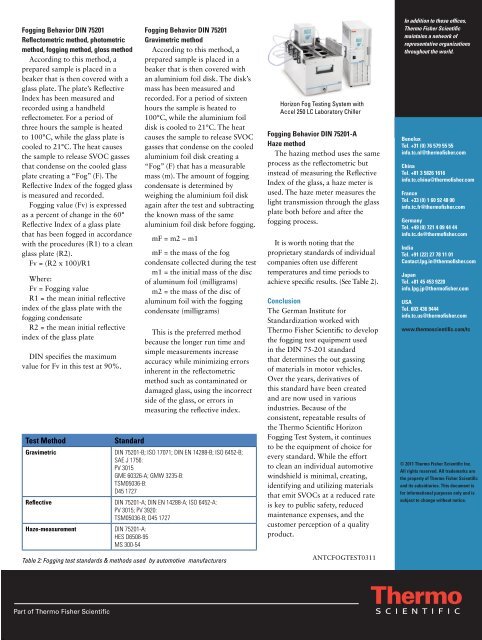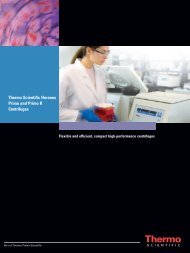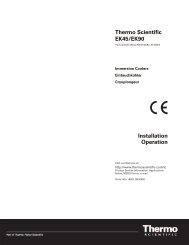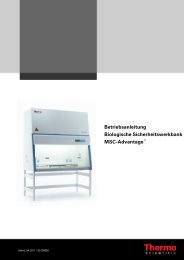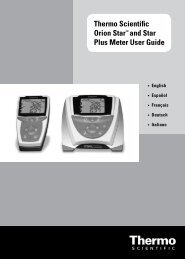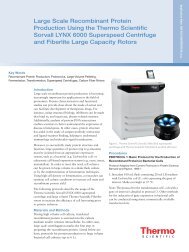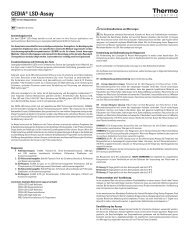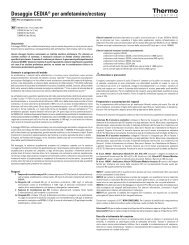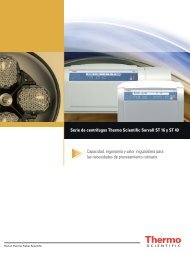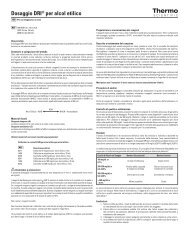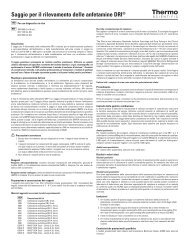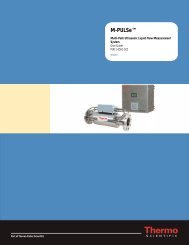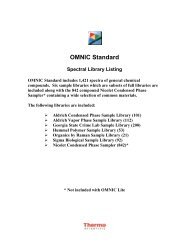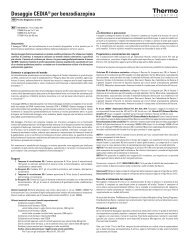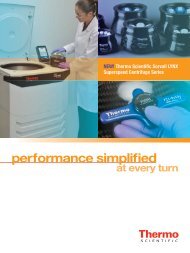Understanding a Fog Testing System - Thermo Scientific
Understanding a Fog Testing System - Thermo Scientific
Understanding a Fog Testing System - Thermo Scientific
Create successful ePaper yourself
Turn your PDF publications into a flip-book with our unique Google optimized e-Paper software.
<strong>Fog</strong>ging Behavior DIN 75201<br />
Reflectometric method, photometric<br />
method, fogging method, gloss method<br />
According to this method, a<br />
prepared sample is placed in a<br />
beaker that is then covered with a<br />
glass plate. The plate’s Reflective<br />
Index has been measured and<br />
recorded using a handheld<br />
reflectometer. For a period of<br />
three hours the sample is heated<br />
to 100°C, while the glass plate is<br />
cooled to 21°C. The heat causes<br />
the sample to release SVOC gasses<br />
that condense on the cooled glass<br />
plate creating a “<strong>Fog</strong>” (F). The<br />
Reflective Index of the fogged glass<br />
is measured and recorded.<br />
<strong>Fog</strong>ging value (Fv) is expressed<br />
as a percent of change in the 60°<br />
Reflective Index of a glass plate<br />
that has been fogged in accordance<br />
with the procedures (R1) to a clean<br />
glass plate (R2).<br />
Fv = (R2 x 100)/R1<br />
Where:<br />
Fv = <strong>Fog</strong>ging value<br />
R1 = the mean initial reflective<br />
index of the glass plate with the<br />
fogging condensate<br />
R2 = the mean initial reflective<br />
index of the glass plate<br />
DIN specifies the maximum<br />
value for Fv in this test at 90%.<br />
Test Method Standard<br />
<strong>Fog</strong>ging Behavior DIN 75201<br />
Gravimetric method<br />
According to this method, a<br />
prepared sample is placed in a<br />
beaker that is then covered with<br />
an aluminium foil disk. The disk’s<br />
mass has been measured and<br />
recorded. For a period of sixteen<br />
hours the sample is heated to<br />
100°C, while the aluminium foil<br />
disk is cooled to 21°C. The heat<br />
causes the sample to release SVOC<br />
gasses that condense on the cooled<br />
aluminium foil disk creating a<br />
“<strong>Fog</strong>” (F) that has a measurable<br />
mass (m). The amount of fogging<br />
condensate is determined by<br />
weighing the aluminium foil disk<br />
again after the test and subtracting<br />
the known mass of the same<br />
aluminium foil disk before fogging.<br />
mF = m2 – m1<br />
mF = the mass of the fog<br />
condensate collected during the test<br />
m1 = the initial mass of the disc<br />
of aluminum foil (milligrams)<br />
m2 = the mass of the disc of<br />
aluminum foil with the fogging<br />
condensate (milligrams)<br />
This is the preferred method<br />
because the longer run time and<br />
simple measurements increase<br />
accuracy while minimizing errors<br />
inherent in the reflectometric<br />
method such as contaminated or<br />
damaged glass, using the incorrect<br />
side of the glass, or errors in<br />
measuring the reflective index.<br />
Gravimetric DIN 75201-B; ISO 17071; DIN EN 14288-B; ISO 6452-B;<br />
SAE J 1756:<br />
PV 3015<br />
GME 60326-A; GMW 3235-B:<br />
TSM05036-B:<br />
D45 1727<br />
Reflective DIN 75201-A; DIN EN 14288-A; ISO 6452-A:<br />
PV 3015; PV 3920:<br />
TSM05036-B; D45 1727<br />
Haze-measurement DIN 75201-A:<br />
HES D6508-95<br />
MS 300-54<br />
Table 2: <strong>Fog</strong>ging test standards & methods used by automotive manufacturers<br />
Horizon <strong>Fog</strong> <strong>Testing</strong> <strong>System</strong> with<br />
Accel 250 LC Laboratory Chiller<br />
<strong>Fog</strong>ging Behavior DIN 75201-A<br />
Haze method<br />
The hazing method uses the same<br />
process as the reflectometric but<br />
instead of measuring the Reflective<br />
Index of the glass, a haze meter is<br />
used. The haze meter measures the<br />
light transmission through the glass<br />
plate both before and after the<br />
fogging process.<br />
It is worth noting that the<br />
proprietary standards of individual<br />
companies often use different<br />
temperatures and time periods to<br />
achieve specific results. (See Table 2).<br />
Conclusion<br />
The German Institute for<br />
Standardization worked with<br />
<strong>Thermo</strong> Fisher <strong>Scientific</strong> to develop<br />
the fogging test equipment used<br />
in the DIN 75-201 standard<br />
that determines the out gassing<br />
of materials in motor vehicles.<br />
Over the years, derivatives of<br />
this standard have been created<br />
and are now used in various<br />
industries. Because of the<br />
consistent, repeatable results of<br />
the <strong>Thermo</strong> <strong>Scientific</strong> Horizon<br />
<strong>Fog</strong>ging Test <strong>System</strong>, it continues<br />
to be the equipment of choice for<br />
every standard. While the effort<br />
to clean an individual automotive<br />
windshield is minimal, creating,<br />
identifying and utilizing materials<br />
that emit SVOCs at a reduced rate<br />
is key to public safety, reduced<br />
maintenance expenses, and the<br />
customer perception of a quality<br />
product.<br />
ANTCFOGTEST0311<br />
In addition to these offices,<br />
<strong>Thermo</strong> Fisher <strong>Scientific</strong><br />
maintains a network of<br />
representative organizations<br />
throughout the world.<br />
Benelux<br />
Tel. +31 (0) 76 579 55 55<br />
info.tc.nl@thermofisher.com<br />
China<br />
Tel. +81 3 5826 1616<br />
info.tc.china@thermofisher.com<br />
France<br />
Tel. +33 (0) 1 60 92 48 00<br />
info.tc.fr@thermofisher.com<br />
Germany<br />
Tel. +49 (0) 721 4 09 44 44<br />
info.tc.de@thermofisher.com<br />
India<br />
Tel. +91 (22) 27 78 11 01<br />
Contact.lpg.in@thermofisher.com<br />
Japan<br />
Tel. +81 45 453 9220<br />
info.lpg.jp@thermofisher.com<br />
USA<br />
Tel. 603 436 9444<br />
info.tc.us@thermofisher.com<br />
www.thermoscientific.com/tc<br />
© 2011 <strong>Thermo</strong> Fisher <strong>Scientific</strong> Inc.<br />
All rights reserved. All trademarks are<br />
the property of <strong>Thermo</strong> Fisher <strong>Scientific</strong><br />
and its subsidiaries. This document is<br />
for informational purposes only and is<br />
subject to change without notice.<br />
2


